By Jeff W. Zimba
Every war is different. Every battleground has diverse characteristics. Each mission, whether a military role or civilian law enforcement detail varies greatly in its specific purposes. It seems almost impossible on the surface that a single weapon system could adapt and function in such a range of climates and missions, but the familiar M16 is still going strong. From a lightweight carbine to a heavy barreled LMG, the M16 weapon system has been fulfilling the role of America’s primary service weapon for more than 40 years and it doesn’t seem it will be replaced wholesale anytime soon.

(DoD photo by JO1 Jackey Bratt, USN)
The earliest history of the inception and design of the black rifle bas been chronicled numerous times and it is not the intent of this author to rehash this historical material other than a very brief and condensed historical summary. There are many credible sources for this information including The Complete AR-15/M16 Sourcebook by Duncan Long, The Black Rifle I by Blake Stevens, Black Rifle II by Christopher R. Bartocci and an extensive Colt M16 ID Guide in the Machine Gun Dealers Bible by Dan Shea. This article will focus on the versatility of the M16, the characteristics that have allowed the metamorphosis from the original designs to the current battle rifle of the 21st century and possibly beyond.
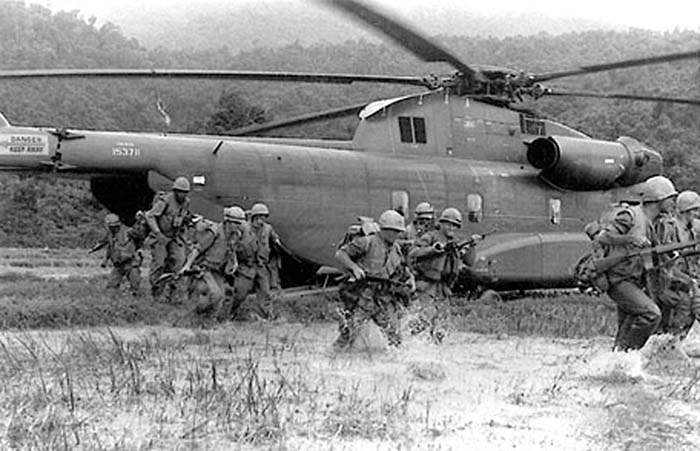
Although there are a countless number of model designations for these rifles from numerous manufacturers, for simplicity purposes in this article, the designation “M16” can be assumed to be a fully automatic rifle while the designation “AR-15” makes reference to the semiautomatic version.
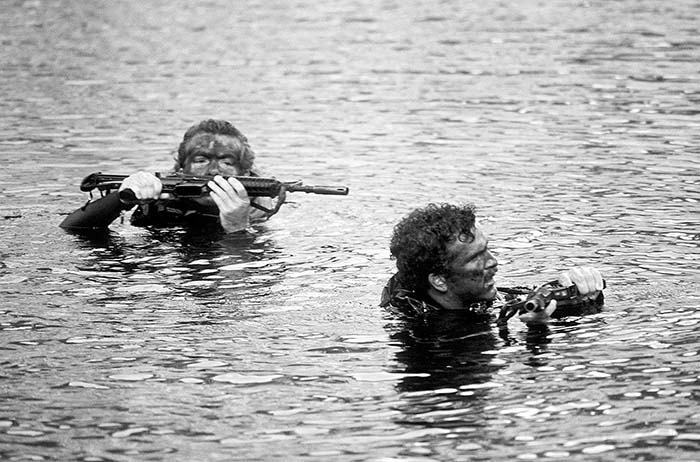
A Very Brief History
While its initial roots are clearly in the Stoner designs of the early 1950s, like most designs, the multiple lug bolt head, lockup into a barrel extension, and gas system principle can be traced back farther. It was at ArmaLite where this all came together. The first heavy public exposure to the black rifle started in the wet and humid environment of the tropics with the earliest variations sent to US troops in Viet Nam. There were many positive responses at first, but after the ammunition/propellant change, the black rifles were plagued with an extremely lackluster initial impression and poor performance in the field. Problems were eventually minimized after several rounds of intense testing combined with numerous committee change recommendations. Many alterations in production were initiated including chamber dimensions, rifling twist ratios, firing-pin changes, redesigning the flash hider and charging handle, and (against the advice of many people) the addition of a forward assist assembly. Along with ammo and gunpowder refinement, proper maintenance, and problems addressed with early magazines, the early version of black rifle as we know it today was on its way to becoming the cornerstone of the modern American military arsenal.

(DoD photo by PH1 Chuck Mussi)
As early as 1963, Colt started manufacturing this “new” rifle in semiautomatic only with the civilian population and the law enforcement community in mind. Sold as the AR-15 Sporter it was virtually identical to the M16 with the exception of the fire control group. With an early retail price of $189.50 it was marketed to the hunting and sporting community as a beacon of a new wave of manufacturing technology allowing it to be lightweight while remaining accurate and effective. Although several minor changes have been made to separate the function of the semiautomatic version of these rifles from their fully automatic relatives over the years, and to keep them from being easily converted to fully automatic, they remain wildly popular and an enormous civilian market thrives today. Numerous upgrades and model enhancements of the civilian line of semiautomatic variants have followed very closely to those designed for the fully automatic models keeping them on a fairly level playing field.
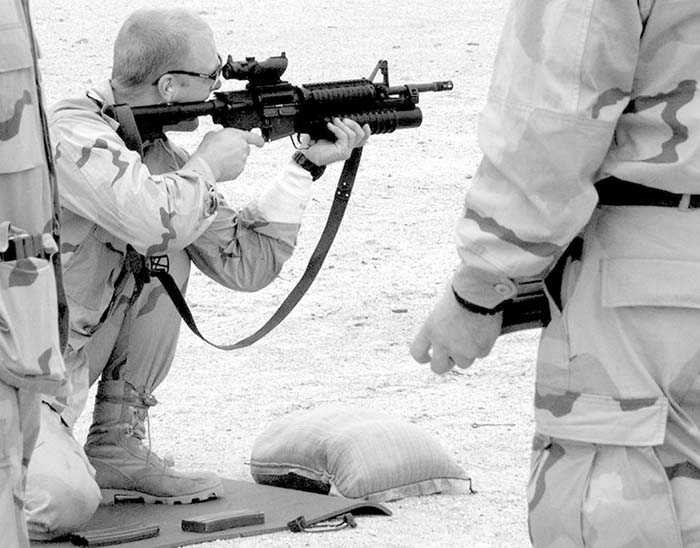
With the 1977 expiration of Gene Stoner’s patent on the M16 gas system, several companies sprang up and started manufacturing their own versions of this popular rifle. The trademark model name of “AR-15” was, and still is, owned by Colt, and they are still one of many businesses that manufacture this weapon system and its many configurations.
Modularity is King
At the heart of the black rifle is the versatile lower receiver. This portion of the firearm is the section considered by federal law to be “the firearm” by definition. The lower receiver is the portion of the firearm that contains the trigger group and the pistol grip as well as the magazine well. Also attached to the lower receiver is the buffer tube and stock. This is the part that requires purchase through a licensed federal firearms licensee (if ordered from an out-of-state dealer) and the paperwork that goes along with any other firearm purchase, depending upon the laws of the State of the buyer. Every other part of this firearm may be ordered directly by the end user and requires no federal licensing or paperwork. All other parts, including the upper receivers and the barrels are treated just like any other non-regulated parts.
The upper receiver plays an equally important role in the mechanism. The upper receiver is the point of attachment for the barrel and the housing for the bolt, bolt carrier and charging handle. It is attached to the lower receiver by two takedown pins that are operable without the aid of any tools. The upper and lower receivers may be separated and rejoined at any time without fear of losing any components under normal handling. This may be attractive for size considerations when breaking down for transportation or when changing the characteristics of the rifle for a specific task.
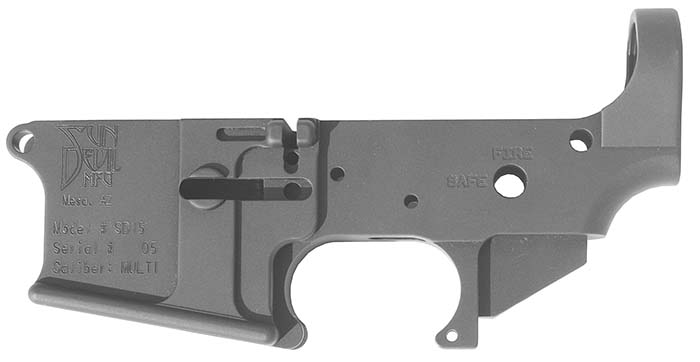
Several rifle configurations may be assembled on a single lower receiver simply by swapping out barreled upper receivers. Specific tasks may require features unique to that task but may not be desirable to others. This is where the real beauty of the black rifle comes in. Unlike most other firearms, the characteristics of the black rifle can be altered at any time, and reversed back again, just by changing upper receivers. It is indeed more than a weapon; it is truly a “weapon system” as it is often properly referred as.
For obvious reasons, an entry-type rifle may consist of a very short barrel and either iron sights or a zero-magnification dot-type sight. A varmint hunting rifle may be much more effective with a long barrel and high power telescopic sight. With a black rifle, both of these configurations are only a quick upper receiver swap away with no lack of performance in either field.
There are barrels ranging from the 7-inch* “Kitty Kat” barrel from DPMS (www.dpmsinc.com) to a 24-inch Varminter Extra Heavy Barrel from Bushmaster Firearms (www.bushmaster.com) and a multitude of lengths in between. (* Under Federal Law a rifle barrel has to be over 16 inches in length to be a legal Title I firearm. By purchasing or registering the rifle as a Short Barreled Rifle, the owner can use any barrel length at will. With registered machine guns, the barrel length is not a legal stipulation under Federal Law and any length barrel may be used). There are not many rifles that allow the flexibility of swapping out barrel lengths without the necessity of tools in less than 30 seconds like this system. Additionally, another major advantage is the sights are part of the upper receiver as well, so there is no need to re-zero after making this swap. If multiple barreled upper receivers are owned, they can all be sighted-in and swapped as desired with a complete return to zero with careful handling and the correct ammunition.
From Plinking to Protecting
If there is any one thing that can always be counted on in the firearms community, it is American Ingenuity and the desire to make something bigger and better. (Sometimes smaller and better, in this case.) Fortunately, this has proven to work well in transforming the once light .223 Rem. (5.56x45mm) rifle into something left only to one’s imagination and budget. With the ease of changing upper receivers, the transformation from the original caliber to a completely new round is almost as simple. Since the upper receiver holds the barrel, bolt and bolt carrier, this is the portion of the rifle where the caliber of the ammunition to be utilized is determined. Thanks to many able minded firearm enthusiasts, these rifles can be converted to almost any caliber ranging from .17 to .50 BMG with minimal (if any) temporary modifications to the lower receiver. From the luxury of plinking for recreation on a budget or additional training, to having the stopping power to assist our front line fighters in the War on Terror, the black rifle can be custom configured to suit every application.

One of the most popular subcaliber units among black rifle shooters is the “Atchisson” .22LR conversion manufactured by Jonathan Arthur Ciener, Inc. (www.22lrconversions.com). When utilized with the recommended ammunition, properly maintained and operated, they provide hours of plinking fun in semiautomatic AR-15s or full automatic fun when used in conjunction with a registered M16. On the opposite end of the ammunition spectrum is the .50BMG Upper Receiver from Watson’s Weapons Inc. (www.watsonsweapons.com). This upper receiver actually allows the use of the massive .50 BMG round when attached to your lower receiver. It functions as a single-shot rifle that must be partially taken down to be reloaded between shots.
One of the most popular pistol caliber conversions would include the 9x19mm (Luger) conversion. First introduced in 1985, Colt offered a 9mm blowback-operated submachine gun that worked quite well. Most of the characteristics were the same as the standard rifle, making operation simple for anyone who had utilized or trained on the 5.56x45mm rifle. A special magazine (both 20-round and 32-round) was developed for the much shorter 9x19mm round and a block was pinned inside the standard lower receiver’s magazine well to accommodate the smaller magazine while utilizing the same magazine release. A civilian version was soon to follow in semiautomatic only with a 16-inch barrel. Other than the upper receiver and bolt differences, only the buffer was changed to a heavier one, and a few of the trigger group parts were slightly modified. In the 1990s, the US Drug Enforcement Agency adopted a silenced version of this rifle. The Department of Energy also adopted a very short variation known as the Model 633, commonly called a “DoE Upper.” The 633 had a 7-inch barrel, collapsible stock and a front handguard to keep the operators hands from straying in front of the muzzle.
Several other companies started manufacturing these pistol caliber conversions with numerous types of feeding systems. While a few emulated the Colt style mag-well block and use the factory Colt 9mm magazines, others used highly modified magazines reworked to fit the interior portion of the factory magazine well. Although many of the modified magazines work very well, they are often expensive and the availability is less than desirable in most cases. Even though there are several manufacturers of aftermarket (any non-Colt) black rifles including several Caliber conversions, the pistol caliber most often encountered remains the 9x19mm.
Many different calibers in black rifle variations have been written about here in the pages of Small Arms Review over the last 10 years. While there are new caliber combinations coming out at an amazing rate, some of the latest ones we are familiar with include the Alexander Arms .50 Beowulf and 6.5 Grendel, (www.alexanderarms.com), .502 Thunder Sabre by Cloud Mountain Armory (www.bigborecanyon.net) and lastly the .45 Bushmaster (www.bushmaster.com). We will be testing the .45 Bushmaster for a future issue of Small Arms Review very soon. Some of the more common calibers include, but are not limited to: .308 NATO*, 7.62x39mm and 6.8SPC and can be found from multiple vendors. (*.308 NATO (7.62×51) requires a different lower receiver due to the longer interior dimension of the magazine well necessary to accommodate that particular round).
Feed Me, Seymour!
Like the hungry man-eating plant named Seymour in the 1960s cult classic film Little Shop of Horrors, a black rifle is always hungry and never seems to be fed enough. Firearms, especially those in a military role, are no exception. The earliest magazine design of the AR-15 was a 25-round magazine, which had problems due to being straight, and was immediately replaced with a 20-round magazine. The first ones were steel “waffle” pattern magazines, which were also immediately replaced with the standard aluminum 20-round magazine that eventually evolved into the 20-rounder so common today. In the mid 1960s, a 30-round magazine was manufactured with a slight curve and it seemed to work great in all new rifles but had a hard time feeding in some, including the earlier ones. This was corrected in part by keeping the top portion of the magazine straight like the 20-round version and starting the curvature at the bottom of the magazine well. These magazines still had a reputation for jamming if they were loaded to 30 rounds, and the SOP was load to 28 rounds. This was corrected later by stabilizing the follower with equal leg lengths.
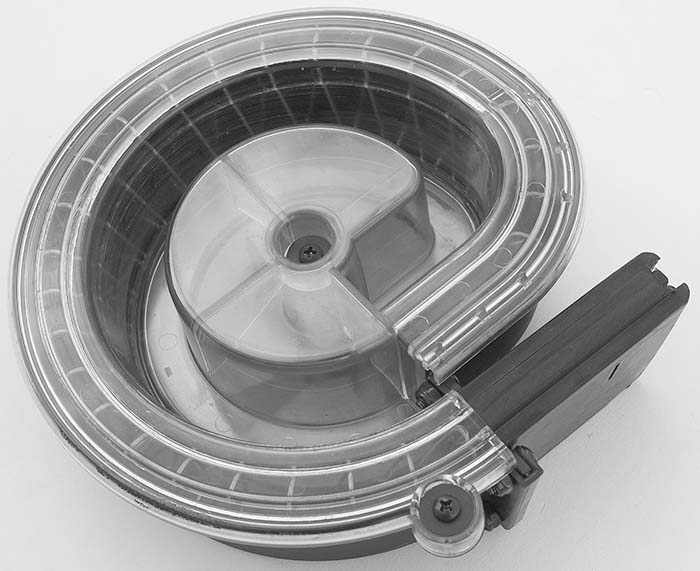
In order to address this “need for feed,” Colt experimented with a belt-feed mechanism that operated with a modified upper and lower. With a 20-inch barrel this unit weighed in at almost 8 1/2 pounds without the bipod or ammo box. The belt fed M16 never made it to production.
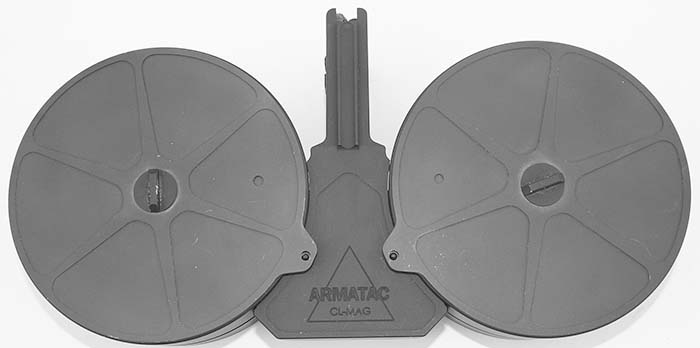
Fast forward to the early 1980s and bring Jonathan Arthur Ciener back into the picture. A manufacturer primarily specializing in sound suppressors at the time, Jonathan took it upon himself to redesign and reintroduce the concept of a belt-fed AR-15 and M16 and made them available to the general public. When they were evaluated for the now defunct Machine Gun News in 1992, this writer had the pleasure of working on the article and spending some trigger time with these guns. We were provided with both a semiautomatic model and a fully automatic model. They were built on factory Colt AR-15 and M16 rifles, and like Colts early design the upper and lower receivers were both modified. The Ciener system had a few very interesting points. First, the belt-feed mechanism could be removed from the weapon and it would again accept factory magazines. Second, Ciener produced some of the belt boxes which locked into the magazine well, as in the original design.
We tested them under several conditions with many types of ammunition in semiautomatic and full automatic. We tested it in belt-feed and magazine feed. We tested it with and without the addition of a sound suppressor. In summary it performed excellently. The only drawback was that in the case of a jam it was a “4-handed” operation to clear it and have it up and running quickly, but with a little practice it could be done quite efficiently. It also used a proprietary, modified link that was quite expensive at the time compared to standard unmodified links. These were sold for a few years but were eventually discontinued due to the enormous amount of time necessary to manufacture them.
There are a few current belt-feed systems for the black rifle but nothing yet has reached a mass marketing level. In the March 2003 issue of Small Arms Review (Vol. 6, No. 6), the Shrike 5.56 from Ares Defense (www.aresdefense.com) was covered in great detail as it was due to be released en masse around the time of publication. To this date, it is still being manufactured, released and shipped in very small quantities due to several redesign upgrades and improvements. The great attraction to the Shrike 5.56 is the fact that it works in conjunction with a completely unmodified lower receiver. All attempts at a belt-fed black rifle in the past have required major lower receiver modifications. Like the Ciener, model it can be fired from belt or box magazine but in the case of the Shrike 5.56, when the belt is out, a box magazine is simply inserted, the rifle charged and firing is uninterrupted. There are no parts to take out or change over. We are anxiously awaiting mass shipments of the Shrike 5.56 and will certainly test the newest production model as soon as they are shipped.
Another interesting belt feed option for the black rifle is the XMG from BRP Guns (www.brpguns.com). The XMG34 is essentially an MG34 “upper receiver” designed for use on an M16 lower receiver. Currently in its 5th year of production this inexpensive alternative to an original MG34 has been receiving great reviews for years. Available in 8mm and in .308, they are popping up at ranges nationwide and are becoming more popular with every passing year. They will function in fully automatic when used in conjunction with a registered lower receiver and require only a small (nonpermanent) modification to function.
Seeing a need for a belt-fed black rifle that is inexpensive to feed, the master of the miniatures, Lakeside Machine of Tippmann Arms fame decided to design a .22LR belt fed upper receiver with a similar mechanism to the popular Tippmann 1/2 scale miniature machine guns. (www.lakesideguns.com). This upper receiver, available for both semiautomatic and fully automatic function, was tested in the April 2006 (Vol. 9, No. 7) issue of Small Arms Review. The only modifications required to the lower receiver in this assembly are the exchange of the factory buffer and the suggested replacement of the hammer spring.
Understanding the demand for more ammo capacity than the 30-round magazines were able to provide, the Beta Company, of Atlanta, Georgia (www.betaco.com) worked with Jim Sullivan of the old ArmaLite and the M16 design fame, the original inventor of the 100-round C-Mag. Sullivan worked as a consultant with Beta Company in the early developmental stages of the new Beta C-Mag and with the introduction and advances in plastic materials and its ability to keep tight tolerances the C-MAG as we know it today has developed into an extremely reliable system, all while keeping weight to a minimum.
Mounting Madness
We live in a market driven economy and combined with the simple truth that necessity is the mother of invention, some “solutions” have been presented to us for “problems” we may never have known existed otherwise. In the last several years there have been an enormous number of accessories manufactured for mounting on MIL-STD-1913 rails. Along with these accessories came a mad rush for mounting platforms, and the standard factory handguards on the AR-15 and M16 are quickly being antiquated and replaced with new and improved rail systems. There are several to choose from including the Knight Rail Interface System (RIS) and Rail Adapter System (RAS) (www.knightarmco.com), VLTOR VIS System (www.vltor.com), POF-USA Predator Rail System (www.pof-usa.com), LMT Monolithic Rail Platform (www.lewismachine.net) and many more. All of the aforementioned have been of excellent quality.
For those not needing the precision, or wishing to spend the amount of money those mentioned may cost, some simple handguard replacements have been introduced that incorporate rails into them and some rail adaptors have been manufactured that simply bolt on to the existing A2-type handguards. A few of those have been utilized for testing devices like vertical grips where a slight amount of movement was not detrimental to the system and they performed fine. Other applications like mounting optics or more “load bearing” accessories would probably not be recommended for the latter systems.
All the new configurations and types of intended deployments these systems are capable of bring the necessity of new support equipment. One area where a serious advancement has been made is in the sighting systems available. Electronic “dot type” sights are very popular for close-up work and there are many types and styles. A few extremely popular systems include the EOTech Holographic Sight (www.eotechinc.com), the Aimpoint CompM4 (www.aimpoint.com) and the Trijicon ACOG (www.trijicon.com). While each system has distinct advantages the author is very familiar with the EOTech model 552. It has several settings for use with a night vision monocular as well as the standard day settings. The Holographic Sight is placed in a forward position on the top rail and utilized as usual during normal daylight. During low light the monocular is mounted behind it so the operator can use it at night without having to re-zero the weapon.
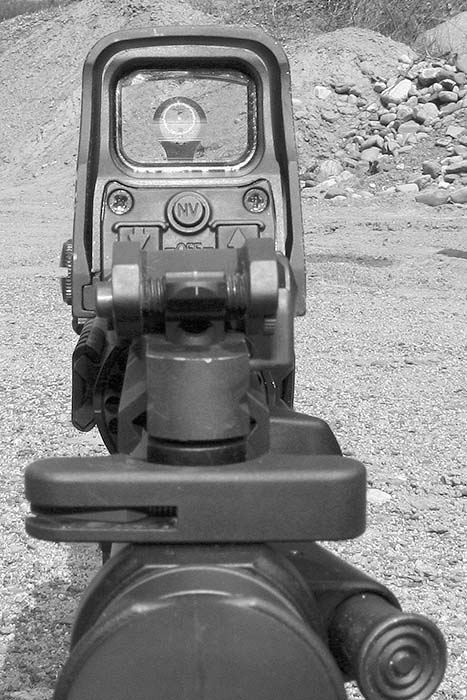
Along with the popularity of low or zero magnification electronic sights, the demand for a well-made, high quality, Back Up Iron Sight (BUIS) has been high for use during a potential electronic failure. Several contenders on the market include the Troy Industries, Inc. Folding Battle Sight (www.troyind.com), the GG&G Flip-Up Sights (www.gggaz.com), and A.R.M.S. Inc., #40 Folding Sights (www.armsmounts.com). An interesting front sight is the POF-USA FTA2005 Front Sight. It is not a folding sight but a stationary sight that is hooded for an extremely fast target acquisition and has been found to be complementary to use in conjunction with “dot-type” sights or as a stand alone with the correct rear BUIS. Due to the great number of new sight requirements, many of the modern rifles are available with a removable carry handle. Once the familiar carry handle and rear sight is removed, a standard MIL-STD-1913 rail is exposed to be used alone or in conjunction with these new sights and rail systems.
Another interesting new front sight was recently introduced for the black rifle. It is made by KNS Precision (www.knsprecisioninc.com) and is actually a circular “peep” with a crosshair in it. Initial testing appears it is fast and accurate and we are anxious to spend more time with this new front sight as well as several more of their latest offerings.
As a Catch-22, these new mounting platforms that were spawned from new items in need of mounts have spun off their own items made to be mounted on this newly available space. There are several devices available for mounting on MIL-STD-1913 rails including visible lasers, IR lasers, and lights. optics, night vision, camera equipment and many more items. Some earlier available items that were designed to mount on standard handguards or directly on the barrel have even been redesigned to mount directly on a rail system due to the high proliferation on later models. A prime example is the new rail mount 40mm LMT M203 Grenade Launcher. This tried and true M16 accessory used to mount on the barrel of the standard black rifle and a special handguard replaced the factory A1 or A2 handguard issued with the rifle. With the new rail mounted version, no additional handguards are necessary and due to the nature of the mounting system there is no longer any stress on the barrel as it is allowed to free-float with many current rail systems.
AR Accessories
As mentioned previously, several companies exist today just to service this weapon system. A quick glance around the Internet or any large, stocking gun shop will uncover thousands of items geared toward users of the AR-15 and M16 weapon systems. A look at KNS Precision and their product line will unveil several components for the black rifle useful in simple preservation roles such as pins that are designed not to rotate and egg-hole the aluminum receivers at the thin section supporting the hammer and trigger pins. They carry a variety of sights for target, plinking, competition and tactical applications and even manufacture a set of Spade Grips so you can shoot the rifle in the same manor as a 1919A4 with butterfly grips or an M60D model. We tested these grips in the May 2007 (Vol. 10, No. 8) issue of Small Arms Review and we found them a blast to shoot, especially with a pintle mount and Beta C-MAG. They are well made and functioned flawlessly.
While you are in research mode, take a peek at some of the products in the Command Arms Accessories line (www.commandarms.com). Some of these accessories manufactured for the AR-15 and M16 weapon system look more like they came back from a fact finding mission from the 22nd Century than from Ivyland, Pennsylvania where they are located. With accessories and upgrades from buttstock to muzzle, the only part of the original weapon system that looks familiar is the distinct shape of the receiver section. Watch for a piece in an upcoming issue of Small Arms Review where we take a “Plain Jane” AR-15 and give it the complete CAA treatment while testing it every step of the way. We are looking for something that really enhances performance and not just cosmetics and we have been assured we will not be disappointed.
Back to the Future
There is one unique feature of the black rifle that is as controversial as all other designs combined. This would be the way the gas system of the firearm operates and whether changing it is considered an upgrade or downgrade by the user. The black rifle operates with a direct impingement gas system in the following manner. When the rifle is fired, the rotating bolt is in its locked position in the barrel extension. As the bullet passes a gas port located under the front sight, some gas is bled off into a gas port and directed through a gas tube to the rear. The hot gas pressurizes the gas tube and the rear end of the pressurized tube is the gas key located on top of the bolt carrier with the gas thus exerting rearward pressure on this movable part. This pressure starts the bolt carrier traveling rearward, unlocking the bolt via its cam pin in the cam path on the carrier, and initiating the extraction. The bolt carrier travels rearward, and the projectile exits the bore evacuating the pressurized gas from the gas tube, ending any rearward pressure from the gas system. That time under pressure is critical to reliability and is dictated by the amount of time the bullet is traveling in front of the gas port. As the bolt carrier passes into the buffer tube (concealed in the stock) the fired casing is ejected. Met with a forward amount of spring tension from the now compressed buffer spring, the bolt carrier is returned to the front, picking up a new round from the magazine, loading it in the chamber and rotating and locking the bolt to restart the sequence.
The problems with this particular system are multiple. It is dumping combustion byproduct – “dirt” – into the same place it feeds ammunition from. This leaves a lot of carbon buildup over time and can create function problems when not maintained regularly. The lower receiver and its trigger group are often heavily soiled from this gas system and it is compounded numerous times over when combined with the use of a sound suppressor. Due to the carbon, unburned powder and extra heat following the path of least resistance, the extra back pressure created with the use of a silencer leaves more debris than normal and blowback is often an unpleasant effect inflicted on the shooter. On top of the maintenance issue, which in the recreational shooting world should be a no-brainer, is an issue not often spoken about. As indicated before, the additional debris is carried back into the action of the gun and it is carried by very hot gas. It has been suggested by some people that the effect of these hot gasses under heavier than normal shooting conditions could cause metal temperament problems over time. A heavy influx of heating and cooling could create some structural problems with extremely heavy use.
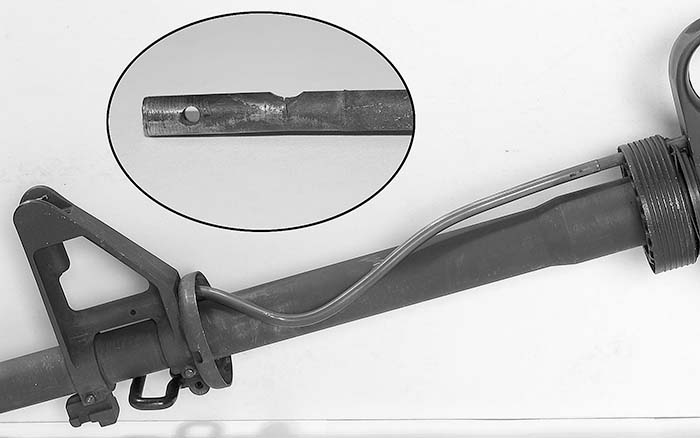
There are several systems that now use a gas piston system in place of the direct impingement system and Small Arms Review has covered several of them in the past. In the last two years we have examined the HK416 System, the POF P-416 System and just recently, the Colt LE1020 Advanced Law Enforcement Carbine. Fairly recently, Ares Defense introduced their GSR-35 Black Lightning system, which is a drop-in piston kit that takes the place of the original gas tube and bolt carrier. Leitner-Wise Rifle Company (www.lwrifles.com) also specializes in a piston system however we have not had the opportunity to evaluate it yet. While the concept is certainly nothing new, (Colt experimented with a piston system in the 1960s, and there are many other examples pre-dating that) its time certainly seems to have come and it appears to be here to stay.
Other than a brief amount of time spent working with an early “Rhino System” in the early 1990s, of all the systems mentioned above, this writer only has an extensive amount of time on the POF P-416 system at this point. Other SAR contributors have extensive trigger time on the HK416, and will cover other systems in the future. On the POF system that I have tested, there are definite advantages that have been witnessed, primarily the number of rounds it is able to run with little or no maintenance with no malfunctions. The POF P-416 utilizes C.R.O.S. (Corrosion Resistant Operating System) where their major components are impregnated with silicon nickel creating an incredibly slick surface. After firing several thousand rounds, the surface easily wipes clean with only a dry cloth, and after almost 20,000 rounds in one particular test unit there is no visible wear on any of the coated parts.
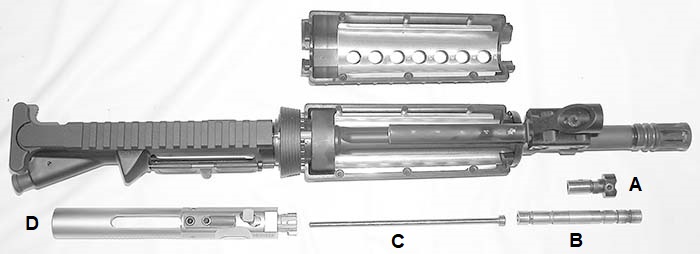
During initial testing the system was fired in excess of 9,000 rounds with no maintenance or lubrication of any kind and when it was finally cleaned because we thought there was a single failure to feed, ending the endurance test, it was later found that it was a faulty magazine creating the feeding problem and not the gun itself. Another factor that assists the P-416 system in functioning so well under harsh treatment is the fact that there are no gas rings necessary since there is no actual gas pushed back into the bolt carrier. This seems to translate into a firearm that will operate in a harsher environment due to much lighter tolerances. Without the presence of gas rings creating a seal between the bolt and bolt carrier, everything moves much smoother and is less meticulous in its typically tight tolerances.
If there is an immediately noticeable advantage in this particular gas piston system it is durability. On top of the several thousand rounds fired with no maintenance except for the initial cleaning after the perceived stoppage, many of them have been in a succession so rapid that it would have been certain failure for a direct impingement system; melting the gas tube and ending the testing very early on. After years of testing black rifles, the author has a collection of failed gas tubes, many resembling spaghetti found lying on top of the barrel after reaching the point of failure. If there are any immediate disadvantages of this gas piston system over a direct impingement system, this author has not yet noticed them.
Now Left Can Be Right
A fantastic example of how the civilian market often takes its own direction and even has the potential to influence the military marketplace is a manufacturer from New Britain Connecticut named Stag Arms, LLC. (www.stagarms.com). Founded in May of 2003, Stag decided to cater to a percentage of the market who had been all but ignored for years. They completely redesigned the upper receiver, bolt and bolt carrier to eject from the left, specifically for left-handed shooters. Featured in the March 2006 (Vol. 9, No. 6) issue of Small Arms Review, southpaws will never again have to depend on a brass deflector keeping hot brass from hitting them or crossing their line of fire.
The Future
It is the versatility of the AR-15/M16 that has allowed it to adapt and thrive in so many differing environments and it is the modularity of the system that is a direct contributor to its survival and evolution. There are a few companies that are addressing this in ways that could never have been originally conceived 40 years ago and will lead the way into a long future for the black rifle.

MGI (www.mgimilitary.com) has been in the black rifle business for decades. Their upgrades have been chronicled in the pages of Small Arms Review several times including their Rate Reducing Buffer – May 2004 (Vol. 7, No. 8), The QCB Upper Receiver – December 2004 (Vol. 8, No. 3) and most recently The Hydra Modular Weapon System – May 2007 (Vol. 10, No. 8). With such versatility as a quick-change barrel upper receiver that requires no tools and works with original factory barrels, changes in length, style and caliber have never been faster, easier or less expensive. The Marck-15 Lower Receiver with interchangeable magazine wells, again with no tools, allows the correct magazine to be used to coincide with the caliber being fired. For example, if you are utilizing a 7.62×37 barrel and bolt, you can use the AK mag-well and utilize standard AK47 magazines. This ensures the correct feed and presentation rather than redesigning a new magazine around an existing space and angle. Mags are inexpensive, available and reliable. Next in the works is a 9mm SMG mag-well that will utilize the factory Colt 9mm SMG magazines. Several new offerings are in the pipeline, some certain to be out even before this magazine hits the newsstand.

Cobb Manufacturing (www.cobb50.com) has a line of rifles called the MCR (Multi Caliber Rifle) and it is based on the design characteristics of the AR-15, just a little bigger. The MCR is a semiautomatic, gas operated system that can be chambered in a long list of calibers from 9mm to 338 Lapua, designed originally for the SCAR rifle program. They are far from newcomers to the industry and have been dealing with such innovative firearms as the .50 BMG FA50 and BA50 for several years. Teamed up with top-line suppressor manufacturers their systems are well made and versatile.
With the “feeding” frenzy a constant issue as discussed previously, we expect to see upgrades and alterations to this portion of the weapon system as long as it is in use. Just before finishing this article the author received what is perhaps the latest offering to the high-capacity quest to evaluate for a future article. It is the CL-Mag from Armatac Industries, Inc. (www.armatac.com). Resembling the Beta C-MAG in shape, the CL-Mag is manufactured from aircraft aluminum and holds 150 rounds of 5.56x45mm. Finished in a hard coat type III anodized finish, it is intended to work in all AR-15/M16 variants. We are anxious to proceed with testing this new feeding system in the near future.
Conclusion
Since there is really nothing to compare the popularity of this unique weapon system to, with its longevity in both military and civilian applications, it is the opinion of this writer that the sheer ability to act as a chameleon and adapt to almost every environment is the life force behind its ever growing popularity. It has to be noted that many of the upgrades and enhancements are civilian based ideas with no military spec sheet giving them direction. Some of these ideas and items can be looked at as simply “fun” and that is an important aspect of shooting that some of us who are a little too hung up on being “professionals” tend to overlook a little too often. Not everything that is discovered or tested has to have an adrenaline soaked special operations application in mind. Some of the best gear for our professional applications stands a chance of starting out as a light-hearted civilian product, just because it is looked at and designed with fresh, new, untainted eyes. Some of the greatest design innovations this writer has witnessed have come from challenges from people who specifically stated that in their professional opinion something couldn’t be done.
With an ever-changing requirement for the ultimate weapon system in this unpredictable War on Terror, if any weapon stands the test of time it is the AR-15/M16. With a virtual flood of new accessories, upgrades, calibers, finishes, furniture and design enhancements being introduced at breakneck speed, this writer has a hard time even thinking of the day where the black rifle or some form of it is not going to be the basis for our primary service weapon for at least 40 more years.
Author’s Note: While this article started out to be a short overview of the AR-15/M16 and its longevity, it soon became obvious that it could not be done in just a few words. The system is too complex and the changes, alterations and upgrades are far too numerous to simply skim over and condense. Unfortunately, due to space constraints, it had to end somewhere and we were not able to include every single company that offers firearms and accessories related to this weapon system. They are far too numerous, and even a quick glance through the pages of Small Arms Review will reveal several more businesses who specialize in parts and accessories for the black rifle. It is not our intention to promote anyone in particular while leaving anyone else out, nor should either be misconstrued as an endorsement or lack of such in the latter case. We would be happy to put together a condensed Black Rifle Buyers Guide listing every business related to this system in the future, but had no room to so in this article.
| This article first appeared in Small Arms Review V11N1 (October 2007) |











